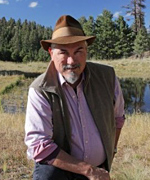 —Alan Dulaney
—Alan Dulaney
Even in the depths of summer, with intense heat and multiple fires, developments occur within the world of water resources.
Water Saved through Conservation
No provider likes to raise rates, yet water conservation works to hold down rate increases. The Alliance for Water Efficiency worked with Tucson and Gilbert to evaluate how far rates would have risen over the last few decades without conservation-related reductions in demand. The results were astounding: Gilbert’s rates were 5.8% less than expected with no conservation and Tucson’s were 11.7% lower. Millions of dollars in infrastructure and supply costs were avoided, and development fees were held down.
Arizona Surface Water Quality Standards
ADEQ has announced a triennial review of surface water quality standards. The first stakeholder meeting was held on June 21 with the goal of obtaining input on topics that ADEQ should review, such as outstanding waters, definitions of effluent-dependent waters, and site-specific standards. Working groups were set up.
Direct Potable Reuse & the New Reclaimed Water Rule
ADEQ has also put out a draft rule on reclaimed water and set up two working groups on standards and infrastructure/technology. Advancements in treatment technology and growing demand have changed views on the value of reclaimed water over the last several years. The new reclaimed water rule incorporates gray water reuse, which has become more common, with Tucson leading in this area. Notably, the rule allows the direct potable reuse (DPR) of reclaimed water — a major topic across the U.S. for several years, as drought has tightened its hold. California and Texas have, by necessity, allowed DPR in areas that were running out of water. The Arizona program will be far more carefully constructed. The next hearing will be July 25.
Water Quality Implications of the CAP System Use Agreement
Water quality is also an issue on the CAP canal. With the signing of the System Use Agreement, CAWCD must now look at the issue of water quality for waters wheeled through the canal. Initially, groundwater from a variety of basins is expected to be introduced into the canal; each source will have a distinct chemical composition. Constituents in Colorado River water historically have exhibited a consistently narrow range of concentrations, and treatment has been designed around this water chemistry. The introduction of groundwater from various basins may shift this range. Varying concentrations of arsenic, fluoride, salts, and other natural components of groundwater may increase treatment costs. CAWCD has convened a Water Quality Standards Task Force that last met in June, and several presentations were made. Stakeholders are developing potential approaches to maintaining CAP water quality. The major issues are whether to use drinking water standards (MCLs; very stringent), surface water quality standards (although the canal is not legally classified as a Water of the United States), or standards defined by CAWCD.
Governor’s Water Augmentation Council
The Governor’s Water Augmentation Council was initiated in 2015 on the basis of a strategic plan from ADWR. Four subcommittees have been formed, each charged with a specific focus: desalination, recycling, long-term augmentation, and finance. Each committee has met several times and developed various approaches. Interestingly, the recycling discussions are coinciding with the development of ADEQ’s reclaimed water rule.
Water Plenary Group
The Governor has also convened a Water Plenary Group to address two major issues facing the state: the Colorado River supply and groundwater overdraft. Working groups have been formed for both concerns. CAWCD presented its viewpoint on Colorado River issues, but ADWR has not posted its presentation. The Groundwater Working Group will first focus on the projected shortfall of groundwater to meet demand, which tops 8.6M acre-feet. Attention then will focus on rural areas where wells are drying up, such as La Paz, Mohave, and Cochise Counties. Results are due in December and will likely be reflected in the 2017 legislative session — which will make it interesting.